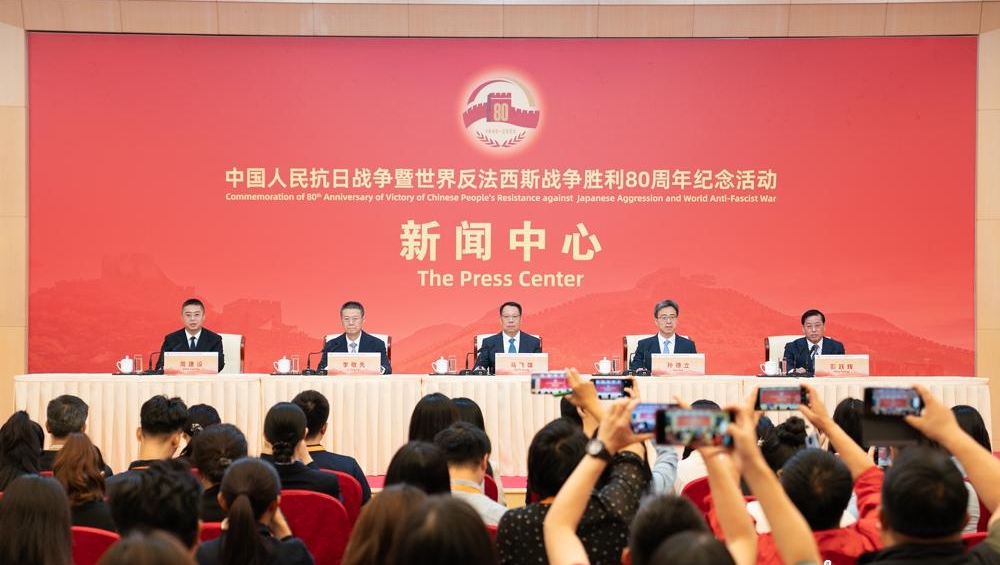Guangming Daily:
Three government departments released a list of recommended thematic exhibitions in July to commemorate the 80th anniversary of the victory in the Chinese People's War of Resistance Against Japanese Aggression and the World Anti-Fascist War. The announcement drew widespread attention. Could you outline the main features of these themed exhibitions? Thank you.
Sun Deli:
Thank you for your question. My colleague was directly involved in this work, so I'll defer to Mr. Peng for the answer.
Peng Yuehui:
I'll take this question. Exhibitions and displays constitute a primary method through which War of Resistance sites and memorial venues tell the stories of the war to educate the public. According to aggregated data, all 31 provinces, autonomous regions and municipalities, as well as the Xinjiang Production and Construction Corps and the Hong Kong and Macao special administrative regions, have all hosted War of Resistance-themed exhibitions. The exhibitions were innovative while maintaining historical accuracy, with improvements in both quantity and quality. They reflected concepts of openness, sharing and integration. The exhibitions garnered widespread attention, support and participation from all levels of government, all social sectors and people from all walks of life. Generally speaking, the highlights of this year's War of Resistance-themed exhibitions can be encapsulated in five keywords.
First, multidimensional storytelling. These exhibitions span a wide range, from the "For National Liberation and World Peace" exhibition to the CPC War of Resistance Against Japanese Aggression archives exhibition, and to displays on the Hundred-Regiment Campaign and the Battle of Taierzhuang. The exhibitions and displays trace the history of the 14-year Chinese People's War of Resistance Against Japanese Aggression. They recreate that great victory through grand narratives and on an epic scale. From tunnel warfare to the heroic railway guerrillas, from the anti-Fascist battlefields in Spain to the anti-Japanese battlefields in China, from international friends to Flying Tigers, various special exhibitions focus on multi-perspective narratives and targeted presentations, making War of Resistance history more comprehensive and authentic.
Second, using physical evidence to tell history. The distinctive feature and outstanding advantage of War of Resistance exhibitions lies in using artifacts to narrate and explain history, letting artifacts speak and historical facts testify. The special exhibition of artifacts unearthed from Northeast Anti-Japanese United Army sites marks the first comprehensive display of such relics. It presents precious cultural relics, archival documents, and historical photographs and scene displays in a multidimensional format, fully showcasing the Northeast Anti-Japanese United Army's arduous struggle and monumental contributions to the War of Resistance. An exhibition themed at the war that changed the world at the Museum of the Communist Party of China uses reports, works and manuscripts by international journalists and foreign writers to vividly demonstrate how the voice of Yan'an was conveyed to the world, helping understand the confidence and hope the CPC provided for the War of Resistance Against Japanese Aggression.
Third, innovative presentation. We combine traditional methods with modern technologies, physical exhibits with scene displays, and static displays with dynamic demonstrations to bridge the gap between history and reality. This continuously enhances the immersive experience, interactive participation and sense of historical connection in War of Resistance exhibitions. A landmine warfare-themed exhibition targets children as its audience, using hand-drawn illustrations combined with multimedia elements to create an original exhibition that visitors can see, hear, touch and experience.
Fourth, emphasizing debut exhibitions. The Museum of the War of Chinese People's Resistance Against Japanese Aggression displayed for the first time the revolutionary martyr certificate of Shen Zhongming, the first underground CPC member who heroically sacrificed his life during the Lugou Bridge Incident. The National Museum of China held its first War of Resistance artifacts exhibition in Hong Kong. Overseas Chinese War of Resistance exhibitions showcased collected qiaopi (overseas Chinese letters with remittances), using stories of ordinary people to reflect profound emotions and telling extraordinary stories of common individuals. These exhibitions showcase the deep patriotic feelings and unyielding spirit of the Chinese people in uniting against aggression.
Fifth, creating synergy. We launched intensive exhibition programs around Jul. 7 and Aug. 15, and will launch more around Sept. 3, featuring four War of Resistance exhibitions at the Museum of the CPC. These also include an exhibition held simultaneously in five locations honoring overseas Chinese contributions to the War of Resistance. We also opened an exhibition jointly held by four provincial museums displaying revolutionary artifacts from anti-Japanese base areas in Shanxi, Hebei, Shandong and Henan provinces. Additionally, four War of Resistance exhibitions opened within seven days in late August in Hong Kong. A thematic exhibition at the Museum of the War of Chinese People's Resistance Against Japanese Aggression has received more than 600,000 visitors over 56 days. The Exhibition Hall of Evidences of Crime Committed by Unit 731 of the Japanese Imperial Army has averaged 3 million visitors annually over the past three years, with daily visitor numbers exceeding 12,000 during this year's summer period. Thank you.


 Share:
Share: 




 京公網(wǎng)安備 11010802027341號(hào)
京公網(wǎng)安備 11010802027341號(hào)